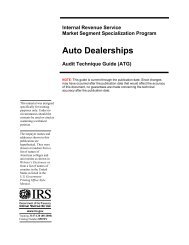Publication 963 (Rev. October 1997) - Uncle Fed's Tax*Board
Publication 963 (Rev. October 1997) - Uncle Fed's Tax*Board
Publication 963 (Rev. October 1997) - Uncle Fed's Tax*Board
Create successful ePaper yourself
Turn your PDF publications into a flip-book with our unique Google optimized e-Paper software.
Determining Worker Status<br />
NOTES<br />
the individual performs or performed the services does not have control of the payment of<br />
the wages, the term employer means the person having control of the payment of the wages<br />
(refer to regulations 31.3401(d)-1(f)).<br />
When a question is raised about the identity of the employer, all facts relating to the<br />
employment must be considered. Copies of any statutory provisions relating to the relationship<br />
should be reviewed. If there is any provision in a statute or ordinance (expressly or<br />
implied) which authorizes the employment of the individual, and the individual is hired under<br />
this authority, the individual is an employee of the State or of the political subdivision to<br />
which the provision applies. If there is no statutory authority (expressed or implied), the<br />
identity of the employer must be determined under the common law control test. Note,<br />
however, that for the purpose of determining whether an employee’s services are covered<br />
for Social Security under a Section 218 Agreement, the employer is always the person for<br />
whom the individual performs services as an employee.<br />
INDEPENDENT CONTRACTOR<br />
If the worker meets none of the criteria previously described and you’ve determined that<br />
the worker is an independent contractor. Federal income tax or FICA taxes are not withheld<br />
from payments. Independent contractors are usually subject to the Social Security and<br />
Medicare taxes imposed under the Self Employment Contributions Act (SECA). If at least<br />
$600 during the year is paid to an independent contractor, a Form 1099-MISC must be filed.<br />
The 1099-MISC identifies:<br />
1. the type of payment,<br />
2. the amount,<br />
3. who made the payment,<br />
4. who received the payment and,<br />
5. backup withholding, if any.<br />
File Form 1099-MISC with the IRS by February 28th. Send all Forms 1099 with Form<br />
1096. The Forms 1099 are used to verify that the independent contractor reported the<br />
payment correctly on her/his income tax return. Send a copy of the Form 1099-MISC to<br />
each independent contractor by January 31, of the following year. Generally, filing a Form<br />
1099-MISC for payments made to corporations is not required unless the corporation is<br />
engaged in providing medical or health care services.<br />
In order to complete Form 1099-MISC, the Taxpayer Identification Number (TIN) of<br />
each independent contractor is needed. The independent contractor should complete a Form<br />
W-9 when services are contracted.<br />
In some circumstances withholding 31 percent income tax from certain payments may be<br />
required. This is called back up withholding. It is required if:<br />
1. a payee does not provide the payer with a taxpayer with a TIN,<br />
2. IRS tells the payer that the TIN is incorrect,<br />
3. IRS notifies the payer that backup withholding is required.<br />
There is a line which is used to report backup withholding on Form 945. Refer to the<br />
instructions on Form 945 as needed.<br />
3-20 Federal-State Reference Guide (<strong>1997</strong> Edition)
















